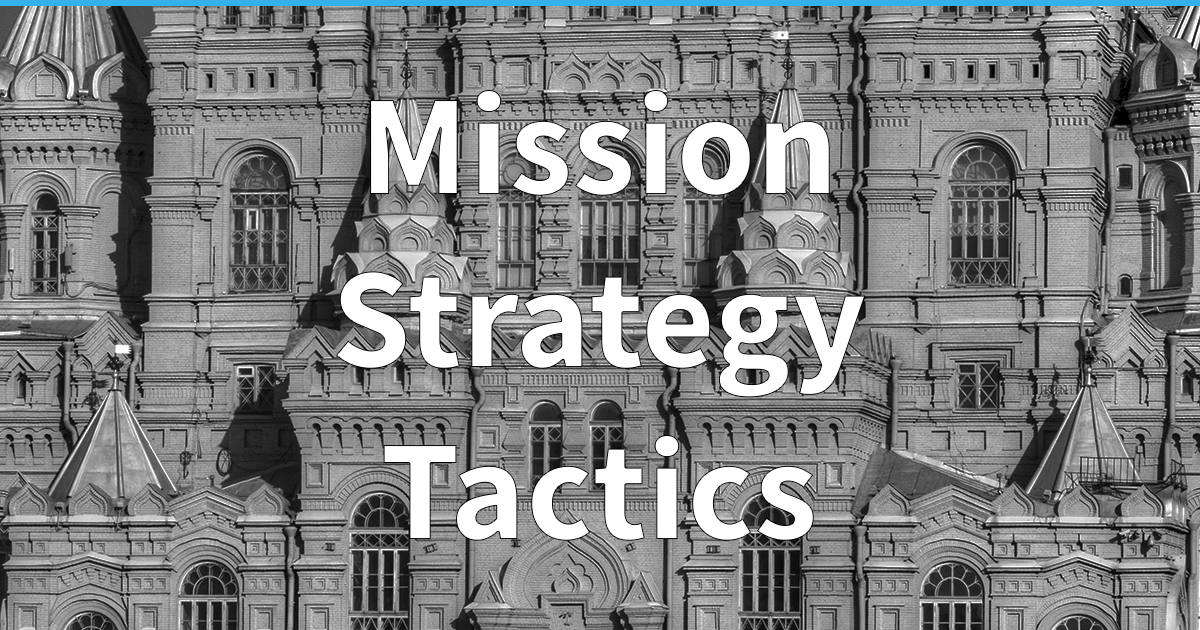Business strategy development: the foundation of any great product strategy
What is strategy? Everyone knows you need one. Most people can't agree upon what it actually is. Even fewer people can provide great examples of what it actually is. Break apart the elements of business strategy in this article.

So my message is in whichever realm, be it going into space or going into the deep sea, you have to balance the yin and yang of caution and boldness, risk aversion and risk taking, fear and fearlessness.
No great accomplishment takes place, whether it be a movie or a deep ocean expedition, or a space mission, without a kind of dynamic equipoise between the two.
Luck is not a factor. Hope is not a strategy. Fear is not an option.
— James Cameron
Strategy in business is about observing the field – aka, the market – and then designing the game you want your company to play.
It's the choices you make, and don't make.
You may believe your company is the only one on the field, but likely there are many players – some on the field, and others entering later – attempting to win this game. The secret is this: most players don't know the rules of the game, and even more don't know that there is a game afoot.
Titans of academia and industry – from Clay Christensen to Richard Rumelt – devoted decades to answering the question: what is strategy? Rumelt defines good strategy as clear, actionable guidelines for future decisions and tactics. In both Rumelt's Good Strategy, Bad Strategy and Sun Tzu's Art of War, a winning strategy is often the unexpected one, catching the competition off guard.
Your business strategy is how you win the battle, and ultimately the war for your customers' trust and loyalty. Before you master business strategy, you need to understand the first principles of business, startups, and growth.
What is a successful business?
While this may seem glaringly obvious, let’s break it down, and answer the question: what makes a business successful?
The anatomy of a business in five parts...
- Value Creation: The purpose of a business is to create and deliver value to its customers.
- Value Capture: Its customers are so happy with the value delivered to them that the business can capture value in return.
- Stakeholders: Stakeholders in the value chain – employees, suppliers, partners, developers, or shareholders – are so happy with the shared value created that it becomes easier to generate more value over time.
- Profit: The delta between value creation and value capture is profit.
- Growth: The increased ability to grow profit fuels future innovation.
A successful business is simply one that efficiently creates and captures value.
What about startups?
Startup: the high-growth value creation machine
Paul Graham defines a startup as a company designed to grow fast. David Friedberg expands upon this definition with a six-stage startup value creation framework:
- Technical Competency: Can you make a product?
- Product/Market Fit: Do people want to buy the product?
- Value Chain: Can you make positive gross margin selling the product?
- LTV>CAC: Can you generate a return on marketing?
- Economies of Scale: Can you scale capital allocation to grow the business?
- Multiple Revenue Streams: Can you be a platform, or multi-product company, extracting additional leverage out of the network you built between customers and suppliers?
Historically, the ethos of Silicon Valley greatly prizes speed and execution, but through the lens of Friedberg's framework, business strategy becomes crucial to sustained success by stage three. Execution velocity is still paramount, but velocity is about moving to the right destination.
How does a business grow?
Anyone working in an enterprise environment frequently hears the phrase strategic objectives. It's the kind of jargon that takes years to enter a startup. If you unpack strategic objectives, they tend to be generic growth levers focused on expansion or margins. This is because business growth generally happens via three levers:
- Improve margins: the business improves customer acquisition or product development efficiency, or raises prices.
- Expand use cases: the business increases revenue through new features, products, or by adjusting existing products to be relevant to adjacent segments.
- Expand markets: the business increases revenue through accessing new markets, typically achieved through new geographies, but also through integrations, new products, or new positioning.
A company aims to increase this growth with a model known as a Flywheel, which is simply a closed-loop system that compounds over time with each trip through the loop. This is how a decade-long company growth chart appears flat until year 6 with a sudden exponential lift from years 7 to 10.

Without happy customers, there is no profit, and there is no business. And without additional value or additional customers, there is no growth. Most businesses seek to capture more value, but in an open market the competition reduces the ease of growth, and this is where business strategy comes into play.
Mission, Vision, Strategy, Goals: the executive fill-in-the-blank exercise to success?
If the purpose of a business is to create and deliver value to customers, then its mission is the specific, unique activity in which it creates value, and its vision is the description of a mission-accomplished future still a decade or more away.
To achieve its mission and reach that vision of the future, business leaders set goals for the organization. But how do leaders select those goals?
A quick glance at most marketing sites within any business category, and it may seem to an outsider that you achieve those goals by merely copying what others in that category are doing.
The styles. The hierarchy. The language.

Next, Google business strategy framework, and you'll find dozens – if not hundreds – of frameworks ready for your fill-in-the-blank strategy needs.

To recap, the path to strategic success so far seems like:
- Step 1: Copy the market leaders
- Step 2: Fill out the right canvas
- Step 3: Profit
Seems easy, right?
Let’s demystify strategy by analyzing the building blocks and motivations behind most business strategies – and there’s no better place to start than with Michael Porter, the creator of modern competitive strategy.
Five Forces, 3 Common Strategies
Michael Porter is a Harvard professor, one of the world’s leading authorities on competitive business strategy, and typically recognized as the creator of the Five Forces framework.
First published in his 1979 Harvard Business Review article, Porter accurately described the five market forces of his time that caused the rise and fall of most commercial endeavors: rivalry between competition, threats from new entrants or substitute products, and bargaining power between suppliers or buyers.

Think of these forces as the inputs to a dynamic market system, analogous to winds in the weather system. But accurately describing the weather has little to do with the specific fashion choices made once you learn that it is pleasantly sunny outside. Planned activities and social signaling determine your final selection as much as the weather, if not more.
The five forces determine economic impact and help shape value chains but don't describe the company's actual business strategy to delight customers and subsequently maximize growth.
Three Common Business Strategies
Porter mapped most businesses to three common operating strategies that become the levers for decision-making within a company. These strategies are:
- Market Price Leader: the business is the low-cost choice, driving a higher market share despite lower customer LTV.
- Differentiation: the business differentiates itself from the competition through the brand, choices, and values behind its products or services, driving a higher customer LTV despite a lower market share.
- Focus: the business focuses on one specific function or market segment, focused on delivering the “best of breed” capabilities, driving a higher customer LTV despite a lower market share.
All come with tradeoffs and many businesses start with one of the common business strategies, but adjust over time. Most businesses find it difficult to choose a strategy and simply adopt a mix-and-match approach, highlighting elements across all three.
You can see these strategies play out in large, familiar products and services, such as Cloud Computing Services seen in the table below:

Beyond Five Forces for Business Strategy
In recent years, Porter went on to outline that every great business strategy has:
- A unique value proposition, addressing: variety, needs, and access
- A tailored value chain, to maximize margins
- Differentiation from rivals, to maximize customer loyalty
- Fit across the value chain, to maximize stakeholder loyalty
- Continuity over time, to maximize brand loyalty
If following one of the three common strategies and creating defensive measures for the five forces was all that mattered, then why is building a successful business so difficult? Enter Hamilton Helmer.
7 Powers for Business Strategy
A Stanford professor, Hamilton Helmer built a career as a strategist, investor, and teacher with a unique model of the underlying Powers creating a winning business strategy called the 7 Powers. Helmer's investment firm deploys a mathematical model of the 7 Powers when selecting bets for their portfolio.
Action, creation, risk—these lie at the root of invention. Business value does not start with bloodless analytics. Passion, monomania, and domain mastery fuel invention. The compelling continuing contribution of founders demonstrates this. Planning rarely creates Power. It may meaningfully boost Power once you have established it, but if Power does not yet exist, you can’t rely on planning. Instead you must create something new that produces substantial economic gain in the value chain. – Hamilton Helmer
Unlike Porter’s forces which are externalities on the business, Helmer’s 7 Powers form the unique moat generated by the business, making it more difficult for challengers to capture market share.

The seven Powers are:
- Economies of Scale – Economies of scale are reductions in unit costs due to an increase in the scale of production. They arise from the increased utilization of capital and labor, the spreading of fixed costs over a larger output or customer base, and the learning that comes with experience, generating operational efficiencies.
- Network Effects – Network effects are positive externalities that arise when one individual's use of a product or service increases the benefits enjoyed by other users. Network effects are important in tech businesses because they can make a product exponentially more valuable as more people use it.
- Branding – Brands are one of the most powerful and durable kinds of moats, but take the most time to build, are complex, and require thoughtful attention. A strong brand can help a product stand out in a competitive market and makes it easier for customers to trust and recommend the product. Brands generate unique loyalty that increases customer retention, decreases price sensitivity, and decreases future customer acquisition costs due to word of mouth.
- Counter-Positioning – Counter-positioning is a type of differentiation that involves positioning your product in such a way that it occupies a different space in the market – and mind of your customers – than your competitors. Counter-positioning ultimately creates a brand and business model that competitors have conflicting incentives with, preventing them from competing effectively.
- Switching Costs – Switching costs are incurred when a customer switches from one product to another. Although present in consumer products, these costs increase in B2B as they can include the cost of retraining employees, the cost of lost productivity while employees are retrained, and the cost of lost customers.
- Cornered Resource – A company corners a resource when it somehow gains preferential access to that resource compared to challengers. Resources include intellectual property, human capital, physical resources, distribution channels, and access to capital.
- Process Power – Process Power is the least obvious Power, which can be extremely difficult to replicate. In many cases, it’s the unique mindset, values, and culture that founders bring to a company.
Compared to Porter’s 5 Forces, these 7 Powers provide leaders with concrete areas to invest capital and time into, directly informing business and product strategy.
Build the strategic moat
The 7 Powers are the primary ingredients to developing your company strategy and moat. The key to making a company enduringly valuable is establishing Power in your company's Origination, Take-Off, or Stability phases. It is unlikely that a company will develop a Power moat once the business is in decline.

If you are reading this article and you feel that your business is in decline, you need to honestly assess the situation. Investing heavily in a business or product strategy may lead to assuming that the strategy was wrong, when in fact, the company is past its ability to come back. The good news is that the job market has never been more attractive for talent like yourself. Exit, if necessary.
Bad Strategy, or how undisciplined work creates mediocre business strategy
What makes a strategy bad? For many it's the absence of one, while for others it's simply plans masquerading as strategy. Most people confuse goals and tactics with a business strategy. And bad strategy simply cascades from business to product.
Bad strategy is more than just the absence of good strategy. Bad strategy has a life and logic of its own, a false edifice built on mistaken foundations. Bad strategy may actively avoid analyzing obstacles because a leader believes that negative thoughts get in the way. Leaders may create bad strategy by mistakenly treating strategy work as an exercise in goal setting rather than problem solving. Or they may avoid hard choices because they do not wish to offend anyone—generating a bad strategy that tries to cover all the bases rather than focus resources and actions. – Richard Rumelt
According to Rumelt in Good Strategy, Bad Strategy there are four characteristics of bad strategy:
- Fluff – Fluff relies on grandiose phrasing to compensate for quality or oversimplification bordering on marketing material instead of clarity. Fluff is the signal that you have not spent time clarifying the strategy.
- Failure to identify the challenge – Without the clarity on the gaps in capabilities, the competition, or other market changes, the strategy doesn't address the key problems to solve.
- Confusing goals with strategy – Goals, metrics, and tactics are the methods for executing the strategy and measuring progress. With only goals, how will the company know what true success looks like?
- Misguided strategic objectives – Strategic objectives are great, but not when they are unrealistic, lack the guidance to go from point A to Z, or fail to focus on a specific set of organizational goals.
Unfortunately, there are four additional areas where strategy goes wrong.
Competing Values and Priorities
If an organization has competing interests within its operations or across its departments, it may be better off choosing one priority and focusing on that, rather than trying to incorporate all of the competing visions. This will help to create a more focused and targeted strategy. You trade short-term pain (debates) for long-term pain (failure).
Strategy Templates
Templates do have their use, but don't rely on generic prompts as a one-and-done exercise. Business strategy canvases and templates help teams articulate ideas when new to strategic thinking, but fail at the depth and nuance strategy requires. Think of these tools like training wheels on the bicycle. You eventually need to learn to ride the bike without them.
False Promise of Positive Thinking
New leaders often focus on ambitious, motivational language, however the most important part of a successful company's strategy is not ambition – but rather competence in execution and a specific competitive advantage. Signaling positive vibes can mask the reality of the situation: hard work is ahead, and hard work is hard.
Strategy Bias
Rumelt highlights five common biases that can lead to bad strategy: the "engineering overreach" bias, the "smooth sailing" bias, the "risk-seeking" bias, the "social herding" bias, and the "inside view" bias. Be aware of these biases and look for outside data that help bring perspective.
After the forces, or How strategy really works
Now that you understand market forces, strategic power, and the heuristics of bad strategy, how do you bring it all together? How does strategy really work?
The best business leaders and entrepreneurs internalize the market dynamics and consumer needs, communicating a clear mission and the unique path to success. They do this without templates or books. They ooze clarity and charisma, with a call to arms their organization can't resist.
What if you are not the best yet? How can you build your strategy muscle?
Start with a simple question.
What would have to be true for you to be right?
From the customer needs, to the market, to the capabilities, to the competition, this question illuminates the risks – and the worries – that something might not be true. From the world of Design Thinking, this is simply inverting the risk, and asking, How Might We? Answering this question creates the hypotheses to test as you execute your strategy.
Is that the only question to answer? No.
In 2013, Roger Martin co-authored a book titled Playing to Win with a former CEO of Proctor & Gamble. In Playing to Win, Martin disambiguates strategy from planning, articulating a clear list of five interrelated questions for ascertaining business strategy.
- What is your winning aspiration? This is your company's singular mission, articulated in a clear mission statement, and coupled with the expected result from achieving this mission.
- Where will you play? This is the playing field that encompasses your market inclusive of the geographies, products, customer segments, and competitors on the field.
- How will you win? This is the specific value proposition and competitive advantage – including your company's 7 Powers – that your customers want.
- What capabilities must be in place? This is the capabilities required by the market and the competitive advantage needed to win – highlighting your missing 7 Powers to invest into.
- What management systems are required? This is the systems of managing and executing the strategy, including communicating to the teams, acquiring customer insight, setting and tracking goals, and the measures of success to track progress.

While the five questions seem deceptively simple, it's critical to iterate until as specific as possible in order to test the assumptions made, build the plan to execute the strategy, and keep score along the way.
And remember, for each, what would have to be true for you to be right?
Playing To Win Business Strategy Canvas
The canvas below is perfect for starting and collaborating on your business strategy journey. If you are just starting out, expect to generate 3-5 unique options to understand the permutations for achieving your mission.

Remember, this canvas is your training, and the moving past the tool signals your strategic maturity. Build the muscle, ditch the training wheels.
Get started clarifying your business strategy by:
- Create the company strategy team (2-3 people)
- Clarify your generic strategy (low-cost, differentiated, focused)
- Understand what drives your business growth
- Deeply understand your market and customers
- Identify your company's 7 Powers (and gaps)
- Map your mission, market, unique val prop, capabilities, and systems
- Quickly research or test gaps in the strategy
- Check your biases along the journey
Once your strategy is ready to roll out:
- Connect team goals to the strategy
- Continually communicate the strategy
- Allocate resources to implement the strategy
- Understand the needs of all players in the strategy system
- Keep a weekly, monthly, and quarterly scorecard
- Celebrate milestones
- Profit
Closing Thoughts
It's hard to know how many companies lack a clear business strategy, but there is data showing that 90% of companies fail to execute their strategy. The default is failure, and it's up to you to change this.
Following a strategic framework is not enough. To win at business is to continually win the hearts and minds of your customers. Doing this requires deeply understanding your customers needs and emotions, then turning these insights into the secrets you share only within your organization.
You can't find secrets without looking for them. There are two kinds of secrets: secrets of nature and secrets about people. Natural secrets exist all around us; to find them, one must study some undiscovered aspect of the physical world. Secrets about people are different: they are things that people don't know about themselves or things they hide because they don’t want others to know.
So when thinking about what kind of company to build, there are two distinct questions to ask: What secrets is nature not telling you? What secrets are people not telling you?
The best entrepreneurs know this: every great business is built around a secret that's hidden from the outside. A great company is a conspiracy to change the world; when you share your secret, the recipient becomes a fellow conspirator. – Peter Thiel
Having a business strategy is a great first step. Enriching that strategy with your secrets and communicating it across the organization is the next step. Follow with developing your product strategy, which informs and depends upon your go-to-market strategy.
Making the system work for all people – employees, partners, and customers – by doing the seemingly impossible is the ultimate key to a winning strategy.
See you next time.
Recommended Reading






